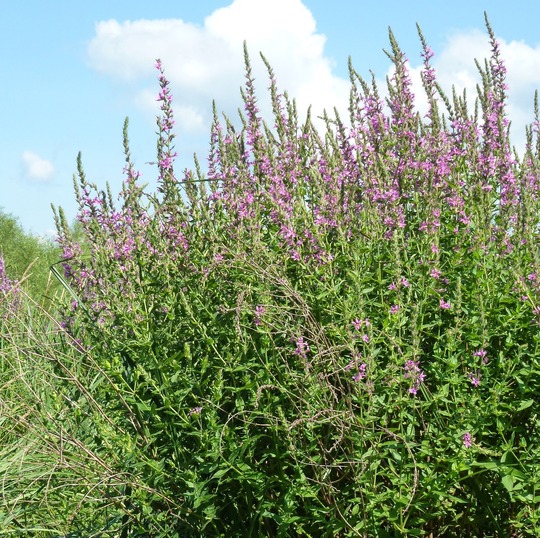|
Having trouble viewing this email? View it as a Web page.
March 1, 2024
March Weed of the Month: Biological Control of Purple Loosestrife in Minnesota
Biological control success is primarily due to two leaf-feeding beetle species
Monika Chandler, Minnesota Department of Agriculture
Purple loosestrife (Lythrium salicaria) was very problematic in Minnesota and other temperate North American wetlands. It is an herbaceous, perennial plant native to Eurasia with the capacity to overtake wetlands including riverbanks, meadows, marshes, lake shores, and ditches. It is a Prohibited Control Noxious Weed in Minnesota because it is widespread and readily infests new areas. Fortunately, biological control has been very successful at reducing loosestrife populations so that native wetland plants can thrive.
 Plants grow 4-7 feet tall and have spikes of purple flowers.
Download photo
Loosestrife is still around, but it is much more controlled now. You will see the attractive spikes of purple flowers in the summer, but it is rare to see vast expanses of loosestrife. This is successful biological control. The aim was not to eradicate loosestrife, but to bring it down to an acceptable level. To maintain this success, biological control efforts should continue.
Biological control success is primarily due to two leaf-feeding beetle species called the black-margined loosestrife beetle (Galerucella calmariensis) and the golden loosestrife beetle (G. pusilla). Prior to importation, these beetles were tested extensively over many years to determine their specificity to purple loosestrife. These beetles look very similar and are often found together in the same field settings, so they are generally both called loosestrife beetles.
 Loosestrife beetle is on a leaf. Feeding damage is visible where beetles chewed leaves.
Download photo
Adult beetles emerge in the spring and feed on loosestrife leaves. They mate and the females lay eggs beginning in the late spring and through the summer. After hatching, the developing larvae eat the loosestrife leaves. Large populations of loosestrife beetles defoliate loosestrife plants, stunting growth and reducing seed production. Adult beetles are collected from sites with high beetle density, then released at new locations. |
|
 |
Beginning in 1992, loosestrife beetles were introduced to the U.S. and Canada by the U.S. Department of Agriculture and multiple university researchers in collaboration with states, counties, and many other organizations. The Minnesota Department of Natural Resources (DNR) leads loosestrife biocontrol efforts in Minnesota. To bulk up beetle populations, beetles were reared on loosestrife plants grown in kiddie pools. Kids were sometimes involved with beetle rearing through their school groups, scouts, or other organizations. In the 1990s, the Legislative-Citizen Commission on Minnesota Resources provided funds for loosestrife rearing kits and coordination. This highly cooperative effort paid off with nearly 2,000 beetle releases in almost all Minnesota counties.
Although loosestrife beetles are the main biological control agents in Minnesota, two other insects were released. One is a root-feeding weevil (Hylobius transversovittatus). The other is a flower-feeding weevil (Nanophyes marmoratus). The status of these species in Minnesota is not well known at this time. Biocontrol efforts continue.
If you are in or near the St. Croix River watershed and would like to get involved, see the Purple Loosestrife Biocontrol Community Science Project run by Wild Rivers Conservancy. The University of Minnesota (UMN) Extension Office is organizing a 2024 loosestrife biocontrol project. Check the UMN Extension’s Terrestrial Invasive Species Participatory Science Projects for information on upcoming loosestrife biocontrol and other 2024 projects.
More information:
MN DNR’s purple loosestrife biological control
Purple loosestrife lifecycle and treatment timing graphic
MEDIA: For more information on Weed of the Month, contact Brittany Raveill, MDA Communications, at brittany.raveill@state.mn.us or 651-201-6131
|